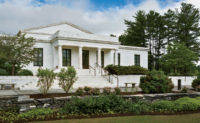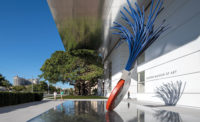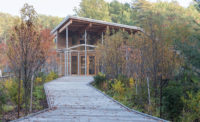Williamstown, Massachusetts
In the late 1990s, Michael Conforti, the director of the Sterling and Francine Clark Art Institute in Williamstown, Massachusetts, decided the Clark sorely needed a renovation and expansion of its existing buildings. In order to attract—and accommodate—visitors to its extraordinary collection of Impressionists and Old Masters in its arcadian setting in the Berkshires, he asked Cooper, Robertson & Partners to come up with a master plan. In 2001, the firm proposed siting a new structure housing a conservation lab and visitor center behind the two major buildings on the Clark campus: the 44,000-square-foot museum, a white marble temple designed in the classical style by Daniel D. Perry in 1955, and the art library next door, the Manton Research Center, a 100,000-square-foot Brutalist behemoth designed by Pietro Belluschi with The Architects Collaborative in 1973.
Conforti was thrilled about Ando, but found his first design placed too much bulk on the site. After long deliberations, the team decided to move the conservation lab to a more remote spot on a hill a 10-minute hike away. “We had always imagined a building there, but didn’t know it would be that one,” Conforti says. Ando completed the 32,000-square-foot conservation lab, known as the Lunder Center on Stone Hill, in 2008.
Finally, last month, the Clark opened Ando’s visitor center, a long, low, modern shed seemingly only one story high. There is a reason it looks small: 65 percent of the 42,600-square-foot two-level structure is below grade.
In plan, it is a rectilinear volume that retains the orthogonal grid of the nearby classical-style museum. But Ando has integrated the new building into the landscape by organizing it around an outdoor reflecting pool and introducing long diagonal walls that dramatically frame the views. The extended planes of the walls pull the eye in prescribed directions.
“It’s all about taking the view away and giving it back to you,” says Gary Hilderbrand of Reed Hilderbrand Landscape Architecture, Ando’s choice of consultant. “I wanted to create a synergy among the buildings with this water feature,” says Ando, known for reflecting pools, such as the dramatic one at his Modern Art Museum of Fort Worth (2002).
The framing walls are a red granite the color of dried blood. The stone is from the same Minnesota quarry that sheathes the Manton. Conforti so loves it, he took a slab to Japan to show Ando early on, and the architect eventually adopted it. “I used stone for the first time, but in a very confident way,” Ando now says. Elsewhere at the center, he employs his signature “Ando concrete,” poured into forms of birch plywood covered with phenolic surface film that make it silky smooth.
One of Ando’s red diagonal walls bounds an enclosed walkway between the center and a new entrance pavilion that Ando designed for the west front of the 1955 museum. (See page 82 for more details of the museum renovation.) Another red wall, perpendicular to the first, extends 340 feet from the center to the parking lot. In plan, these two walls form a “7”–a motif Ando previously employed at the Lunder Center up the hill.
Visitors might initially find the emphasis on solid stone oppressive: the 12-foot-tall walls are the first thing you see after you park; they channel you to the center while blocking views of nearly everything else.
Then comes the surprise, when you enter the lobby, as your gaze is pulled through the building to the glass wall and beyond to the three-tiered reflecting pool and, in the distance, the Stone Hill meadow and the Berkshires. It is breathtaking. In fact, you are looking through two walls: a freestanding, 115-foot-wide concrete one on the outdoor terrace has huge openings incised to “double frame” the view. It makes you think of Le Corbusier.
Ando’s visitor center includes, on the ground level, a reception area, shop, and multipurpose space for temporary exhibitions, conferences, or events. To inaugurate this gallery, Conforti asked Selldorf to design the installation of an exhibition of ancient bronzes from the Shanghai Museum (through September 21). Selldorf executed elegantly proportioned vitrines for the ancient vessels and mounted a temporary screen of diaphanous gauze to filter the sunlight and give the open, airy space a sense of enclosure.
The main lobby adjoining this gallery is dramatically pierced by a switchback stair to the lower level café. It seems to float in the double-height atrium. If the layout appears labyrinthine, it is. As Conforti says, “ You cannot know the building until you go through it and it reveals itself.”
Ando’s new building shares a quiet, minimalist sensibility with its older sister up the hill, the Lunder Center, which has studio spaces, classrooms, and more galleries in addition to the labs, plus an expansive terrace with views of Vermont’s Green Mountains to the north. The two structures, which add 97,700 square feet of space to the Clark campus (including the physical plant), sit snugly in the landscape and provide serene, luminous spaces for art. Both offer a sense of progression and a seamless integration of indoor and outdoor spaces, including framed views. Says Ando, “It is my intention for people to easily experience the spirit and beauty of nature through architecture.” From that perspective, mission accomplished.
The New York TimesSmithsonian.
Peopleclient : design architect : executive architect : USA design team: project leadership (Clark): owner's reprentative: project manager: architect of record/ Ambrose Aliaga-Kelly, AIA, Principal, Project Manager landscape architect: master plan: consulting architect: retail/cafe design: structural engineer: consulting engineers: lighting consultant mep engineer: civil engineer: elevator consultant: security consultant: code consultant: food service consultant: food service consultant: AV consultant waterproofing consultant: water feature consultant: graphic design commissioning agent: program consultant: concrete consultant: curtainwall consultant: furniture distributor: cost estimator: Irrigation Soils Size: 42,600 square feet Project cost: $145 million Completion date: July 2014 |
Productscontractors / suppliers : construction management: concrete works : stone: masonry steel structure: glazing : wood flooring: tile and pavers ornamental metal painting fire protection doors and hardware interior partitions: shades: ceilings millwork : roofing: waterproofing: elevators mechanical controls: electrical systems : mechanical system : plumbing: security landscaping: sitework. signage structure : finish : |


















Post a comment to this article
Report Abusive Comment